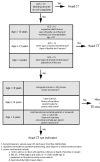Traumatic alterations in consciousness: traumatic brain injury
- PMID: 20709244
- PMCID: PMC2923650
- DOI: 10.1016/j.emc.2010.03.003
Traumatic alterations in consciousness: traumatic brain injury
Abstract
Mild traumatic brain injury (mTBI) refers to the clinical condition of transient alteration of consciousness as a result of traumatic injury to the brain. The priority of emergency care is to identify and facilitate the treatment of rare but potentially life-threatening intracranial injuries associated with mTBI through the judicious application of appropriate imaging studies and neurosurgical consultation. Although post-mTBI symptoms quickly and completely resolve in the vast majority of cases, a significant number of patients will complain of lasting problems that may cause significant disability. Simple and early interventions such as patient education and appropriate referral can reduce the likelihood of chronic symptoms. Although definitive evidence is lacking, mTBI is likely to be related to significant long-term sequelae such as Alzheimer disease and other neurodegenerative processes.
Copyright 2010 Elsevier Inc. All rights reserved.
Figures

References
-
- The Concussion/mTBI Working Group. VA/DoD Clinical Practice Guideline for Management of Concussion/mTBI. [October, 2009]. Available at: http://www.dvbic.org/images/pdfs/Providers/VADoD-CPG---Concussion-mTBI.aspx.
-
- ACRM. American Congress of Rehabilitation Medicine Mild Traumatic Brain Injury Committee of the Head Injury Interdisciplinary Special Interest Group. Definition of mild traumatic brain injury. The Journal of Head Trauma Rehabilitation. 1993;8(3):86–87.
-
- National Center for Injury Prevention and Control. Report to Congress on Mild Traumatic Brain Injury in the United States: Steps to Prevent a Serious Public Health Problem. Atlanta, GA: Centers for Disease Control and Prevention; 2003.
-
- Lange RT, Iverson GL, Franzen MD. Neuropsychological functioning following complicated vs. uncomplicated mild traumatic brain injury. Brain Inj. 2009;23(2):83–91. - PubMed
Publication types
MeSH terms
Substances
Grants and funding
LinkOut - more resources
Full Text Sources
Medical

